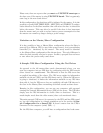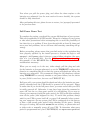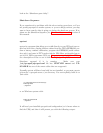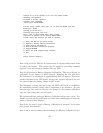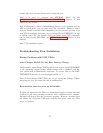At the same time, it sends the same message to the system log and to the
temporary EVENTS file (/etc/apcupsd/apcupsd.events).
Plug the serial port plug back into your computer, and within about 12
seconds, apcupsd should reestablish communications and broadcast and log
the following message:
Communications with UPS restored.
If these messages are logged but not broadcast, either you have your
mesg permission set to no (see man wall or man mesg), or there is
a problem with apccontrol. If you are running a window manager such
as GNOME and don’t have a console window open, you may not re-
ceive the wall messages. However, you should find them in your system
log file (normally /var/log/messages and in the temporary EVENTS file,
/etc/apcupsd/apcupsd.events. For example, to observe these events in the
temporary EVENTS file, you might do a
tail -f /etc/apcupsd/apcupsd.events
Note, if you have installed from the RPM, the proper events file may be
/var/log/apcupsd.events. You can find the actual filename by checking your
apcupsd.conf file.
before running the test.
If you do not observe these messages, you should correct this problem before
proceeding with additional tests.
Simulated Power Fail Test
At this point, you should verify that in the event of a power fail apcupsd
properly calls apccontrol. This test is appropriate for all models of UPSes
(smart or dumb).
To avoid the possibility that apcupsd might shut down your sys-
tem, locate where apccontrol resides on your system (normally,
/etc/apcupsd/apccontrol. Move this script to another location e.g. apccon-
trol.save and replace it with the script found in examples/safe.apccontrol.
When that is done, ensure that your UPS battery is fully charged and that
you have at least 5 minutes of remaining runtime on the batteries. This can
be done by examining the values of the BATTCHG and TIMELEFT
variables in the printout of apcaccess status.
64



